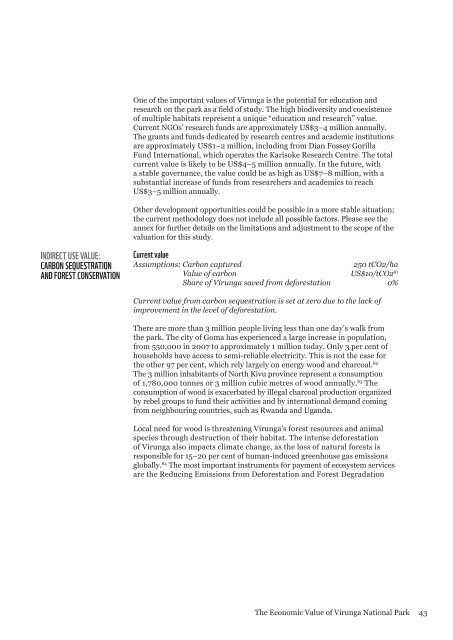The Economic Value of Virunga National Park - World Wildlife Fund
The Economic Value of Virunga National Park - World Wildlife Fund
The Economic Value of Virunga National Park - World Wildlife Fund
You also want an ePaper? Increase the reach of your titles
YUMPU automatically turns print PDFs into web optimized ePapers that Google loves.
One <strong>of</strong> the important values <strong>of</strong> <strong>Virunga</strong> is the potential for education andresearch on the park as a field <strong>of</strong> study. <strong>The</strong> high biodiversity and coexistence<strong>of</strong> multiple habitats represent a unique “education and research” value.Current NGOs’ research funds are approximately US$3–4 million annually.<strong>The</strong> grants and funds dedicated by research centres and academic institutionsare approximately US$1–2 million, including from Dian Fossey Gorilla<strong>Fund</strong> International, which operates the Karisoke Research Centre. <strong>The</strong> totalcurrent value is likely to be US$4–5 million annually. In the future, witha stable governance, the value could be as high as US$7–8 million, with asubstantial increase <strong>of</strong> funds from researchers and academics to reachUS$3–5 million annually.Other development opportunities could be possible in a more stable situation;the current methodology does not include all possible factors. Please see theannex for further details on the limitations and adjustment to the scope <strong>of</strong> thevaluation for this study.INDIRECT USE VALUE:CARBON SEQUESTRATIONAND FOREST CONSERVATIONCurrent valueA s s u m pt i on s: C arb on c a pt u r e d25 0 t C O 2/ h a<strong>Value</strong> <strong>of</strong> carbon US$10/tCO2 81Share <strong>of</strong> <strong>Virunga</strong> saved from deforestation 0%Current value from carbon sequestration is set at zero due to the lack <strong>of</strong>improvement in the level <strong>of</strong> deforestation.<strong>The</strong>re are more than 3 million people living less than one day’s walk fromthe park. <strong>The</strong> city <strong>of</strong> Goma has experienced a large increase in population,from 550,000 in 2007 to approximately 1 million today. Only 3 per cent <strong>of</strong>households have access to semi-reliable electricity. This is not the case forthe other 97 per cent, which rely largely on energy wood and charcoal. 82<strong>The</strong> 3 million inhabitants <strong>of</strong> North Kivu province represent a consumption<strong>of</strong> 1,780,000 tonnes or 3 million cubic metres <strong>of</strong> wood annually. 83 <strong>The</strong>consumption <strong>of</strong> wood is exacerbated by illegal charcoal production organizedby rebel groups to fund their activities and by international demand comingfrom neighbouring countries, such as Rwanda and Uganda.Local need for wood is threatening <strong>Virunga</strong>’s forest resources and animalspecies through destruction <strong>of</strong> their habitat. <strong>The</strong> intense deforestation<strong>of</strong> <strong>Virunga</strong> also impacts climate change, as the loss <strong>of</strong> natural forests isresponsible for 15–20 per cent <strong>of</strong> human-induced greenhouse gas emissionsglobally. 84 <strong>The</strong> most important instruments for payment <strong>of</strong> ecosystem servicesare the Reducing Emissions from Deforestation and Forest Degradation<strong>The</strong> <strong>Economic</strong> <strong>Value</strong> <strong>of</strong> <strong>Virunga</strong> <strong>National</strong> <strong>Park</strong> 43
















